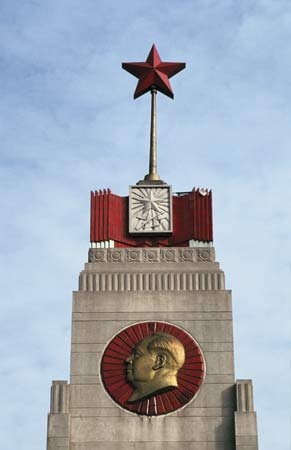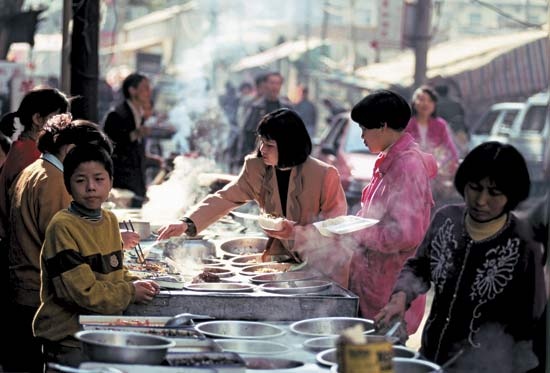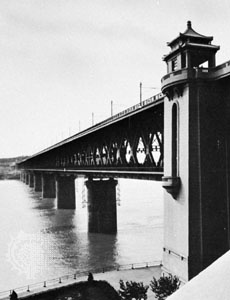Wuhan
China
Introduction
Wade-Giles romanization Wu-han
 capital and major industrial and commercial city of Hubei (Hupeh) sheng (province), China. It is located at the confluence of the Han (Han River) and Yangtze (Yangtze River) rivers and consists of a conurbation of three adjacent former cities— Hankou (Hankow), Hanyang, and Wuchang. Hankou lies on the north bank of the Yangtze River (Chang Jiang) at the mouth of the Han River. Immediately across the Han from it is the older town of Hanyang, and across from these two, on the south bank of the Yangtze, is the ancient metropolis of Wuchang, which is the seat of the provincial government. In 1949 the government of the newly formed People's Republic of China merged the three cities into the single entity of Wuhan.
capital and major industrial and commercial city of Hubei (Hupeh) sheng (province), China. It is located at the confluence of the Han (Han River) and Yangtze (Yangtze River) rivers and consists of a conurbation of three adjacent former cities— Hankou (Hankow), Hanyang, and Wuchang. Hankou lies on the north bank of the Yangtze River (Chang Jiang) at the mouth of the Han River. Immediately across the Han from it is the older town of Hanyang, and across from these two, on the south bank of the Yangtze, is the ancient metropolis of Wuchang, which is the seat of the provincial government. In 1949 the government of the newly formed People's Republic of China merged the three cities into the single entity of Wuhan.The triple city of Wuhan has a geographical centrality that gives its site immense strategic and commercial significance. Lying at the very heart of China, it is roughly equidistant from the cities of Beijing and Guangzhou (Canton) (Canton) on a north-south axis and also is equidistant from Shanghai and Chongqing (Chungking) on an east-west line. Pop. (2002 est.) 4,593,410; (2007 est.) urban agglom., 7,243,000.
History
The earliest settlement in the area, during the Xi (Western) Zhou (Zhou dynasty) period (1046–771 BCE), was to the southeast of Wuchang, which became a capital city of the Wu dynasty during the Three Kingdoms (Sanguo) period (220–280 CE). The primarily administrative role of Wuchang continued throughout the Yuan (Yuan dynasty) (1206–1368) and Ming (Ming dynasty) (1368–1644) dynasties, when it served as a provincial capital.
Hanyang was founded during the Sui dynasty (581–618 CE) but was of minor commercial significance. In contrast, Hankou (then known as Xiakou) became known during the Song dynasty (960–1279) as one of China's four major commercial cities. The opening of Hankou to foreign trade under the terms of the treaties of Tianjin (1858) between China, France, and Great Britain gave added impetus to the commercial and industrial development of the three cities. Concessions in Hankou were granted between 1861 and 1896 to British, French, German, Japanese, and Russian interests, and a number of foreign commercial, trading, and shipping firms opened offices there during that period.
The three Wuhan cities played a prominent role in the 20th-century history of China. The Chinese Revolution of 1911–12, which toppled the Qing (Manchu) dynasty (Qing dynasty), broke out in the army barracks at Wuchang, and the line of heights overlooking the Han River there was the scene of the principal fighting between the imperial and revolutionary troops—the main objective being the government arsenal at Hanyang. Hankou's workers were in the forefront of the general strike of 1923, which was the first large-scale worker industrial action in China. The capture of Hankou by the Nationalist (Nationalist Party) (Kuomintang) armies marching northward from Guangdong province in December 1926 marked the extension of Nationalist power to the middle Yangtze valley. It was followed by a serious mob onslaught on the British concession in Hankou, after which an agreement was reached replacing the British municipal council there with one of mixed Chinese and British composition. The Wuhan cities soon afterward became a centre of conflict between the Nationalists and communists in their short-lived coalition government. After the split between the Nationalists and the communists in 1927, a left-wing faction of the Nationalists maintained its headquarters in Hankou. Mao Zedong, the future communist and national leader, ran a Peasant Movement Institute in Wuchang, where the Fifth Congress of the Chinese Communist Party was convened in 1927.
After the fall of the Nationalist capital of Nanjing (Nanking) to the invading Japanese in 1937, the Chinese government withdrew to Hankou, which temporarily became the base for Chinese resistance. Hankou fell to the Japanese in October 1938 after a defense that lasted more than four months, and the city was occupied by the Japanese until 1945, after which it reverted to Nationalist control. The three cities were taken by the Chinese communist forces in 1949.
The contemporary city
 Hankou's development as a port in close contact with European commerce brought the three cities early under the influence of Western industrialism, and in the 1890s Hanyang became the site of the first modern steel plant in China. The Wuhan cities' steel industry declined during the Japanese occupation, and in 1938 the Nationalists dismantled the Hanyang steel plant and relocated it at Chongqing. Wuhan's steel industry was gradually revived in the 1950s, and by the late 20th century Wuhan had become the second most important metallurgical centre of China (after Anshan). It has several large iron- and steel-producing complexes, including a plant on the south bank of the Yangtze about 15 miles (25 km) east of Wuchang. Iron ore is obtained from the large mine at Daye, which is about 56 miles (90 km) southeast of Wuhan. Coal is shipped from the major Enan field, which lies to the south of the city.
Hankou's development as a port in close contact with European commerce brought the three cities early under the influence of Western industrialism, and in the 1890s Hanyang became the site of the first modern steel plant in China. The Wuhan cities' steel industry declined during the Japanese occupation, and in 1938 the Nationalists dismantled the Hanyang steel plant and relocated it at Chongqing. Wuhan's steel industry was gradually revived in the 1950s, and by the late 20th century Wuhan had become the second most important metallurgical centre of China (after Anshan). It has several large iron- and steel-producing complexes, including a plant on the south bank of the Yangtze about 15 miles (25 km) east of Wuchang. Iron ore is obtained from the large mine at Daye, which is about 56 miles (90 km) southeast of Wuhan. Coal is shipped from the major Enan field, which lies to the south of the city.The iron and steel base has attracted other industries producing chemicals, fertilizers, electrical equipment, glass, agricultural machinery, railroad cars, and trucks. Wuhan is also one of the largest manufacturers of heavy machine tools in China. Its consumer industries produce watches, bicycles, and radios and other electronic instruments. Older industries in Wuhan include rice, oil, and flour mills and factories making cotton and woolen fabrics and other textiles. Cement works, paper mills, distilleries, and soap factories are among Wuhan's other light industries. It is also the site of one of China's more important arsenals. The surrounding agricultural area produces wheat, tea, rice, and cotton.
 Wuhan is crossed by converging maritime, river, rail, and road transportation routes from almost every direction. As the meeting point of these routes, the city has long been the chief collecting and distribution point for the products of the middle Yangtze valley and for west and southwest China, particularly for tea, cotton, silk, timber, and tung oil and a variety of manufactured goods. The Yangtze, the greatest of China's arterial waterways, is navigable for large oceangoing vessels up to Wuhan—which can therefore be considered the head of ocean navigation on the river, although the city is some 600 miles (965 km) from the coast. The main north-south railroad linking Beijing and Guangzhou crosses the Yangtze on a bridge (completed 1957) at Wuhan. Several more rail and highway bridges across the Yangtze have been constructed at Wuhan since 1990, and work was completed on a highway tunnel under the river in 2008. Large bridges also span the Han River and connect Hankou with Hanyang. More railways east from Anhui and Jiangxi provinces and west from Shaanxi province plus major expressways from Beijing to Guangzhou and from Shanghai to Chengdu crisscross the region. The first line of an urban light-rail mass-transit system opened in 2004.
Wuhan is crossed by converging maritime, river, rail, and road transportation routes from almost every direction. As the meeting point of these routes, the city has long been the chief collecting and distribution point for the products of the middle Yangtze valley and for west and southwest China, particularly for tea, cotton, silk, timber, and tung oil and a variety of manufactured goods. The Yangtze, the greatest of China's arterial waterways, is navigable for large oceangoing vessels up to Wuhan—which can therefore be considered the head of ocean navigation on the river, although the city is some 600 miles (965 km) from the coast. The main north-south railroad linking Beijing and Guangzhou crosses the Yangtze on a bridge (completed 1957) at Wuhan. Several more rail and highway bridges across the Yangtze have been constructed at Wuhan since 1990, and work was completed on a highway tunnel under the river in 2008. Large bridges also span the Han River and connect Hankou with Hanyang. More railways east from Anhui and Jiangxi provinces and west from Shaanxi province plus major expressways from Beijing to Guangzhou and from Shanghai to Chengdu crisscross the region. The first line of an urban light-rail mass-transit system opened in 2004.Wuhan is the seat of Wuhan University, which was founded as Ziqiang Institute in 1893 and designated a university in 1928; Huazhong (Central China) University of Science and Technology (1953), which merged with three other institutions in 2000; and dozens of other schools of higher learning. Among places of historic interest are the Changchunguan, a Daoist temple rebuilt east of Wuchang at the end of the 19th century; the Guqintai, an 8th-century pavilion in Hanyang; and a Yuan-dynasty temple and shrine in Wuchang. The Hubei Provincial Museum (1953), also in Wuchang, has notable displays of artifacts from the Spring and Autumn (Spring and Autumn Period) (Chunqiu; 770–476 BCE) and Warring States (Zhanguo; 475–221 BCE) periods.
- Union Bank of Switzerland
- Union Carbide Corporation
- Union City
- Union College
- Union League
- Union of American Hebrew Congregations
- Union of Brest-Litovsk
- Union of Evangelical Christian Baptists
- Union of Liberation
- Union of Lublin
- Union of Needletrades, Industrial and Textile Employees
- Union of Orthodox Jewish Congregations of America
- Union of Soviet Socialist Republics
- Union of Soviet Socialist Republics, flag of
- Union Pacific Railroad Company
- union shop
- Uniontown
- unique-headed bug
- unisexuality
- UNISON
- Unisys Corporation
- UNITA
- Unitarianism and Universalism
- Unitarian Universalist Association
- unitario